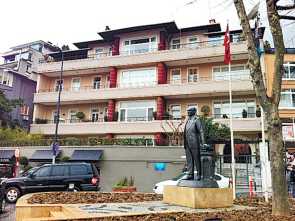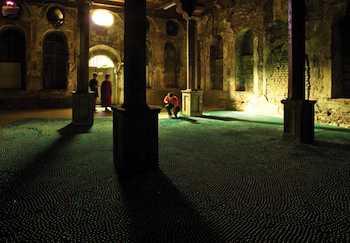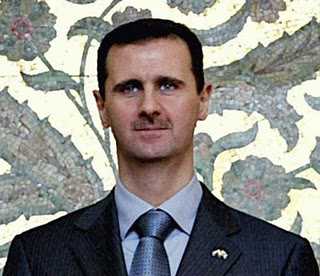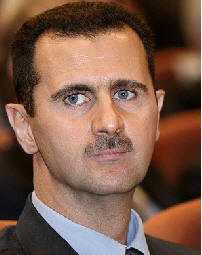A walk through Istanbul with Martin Vialon, a German scholar who is memorializing the work of Erich Auerbach, founder of comparative literature studies, who found refuge there when Turkey opened its gates to academics fleeing Nazism.
By Benny Ziffer

Visible through the windows of the Kitchenette restaurant is a broad ceremonial square, bustling with life even under lowering skies and bitter cold. Outside, the snow and rain intermix and pelt the tiled paving and the buses and the row of yellow taxis waiting for clients outside the Marmara luxury hotel. In the center of the square, passengers emerging from the subway cringe for a moment at the encounter with the freezing cold. Quickly, they scatter and disappear behind the gray curtain of precipitation that blurs the lines of the buildings around the square and softens the stiff contours of an old-fashioned concrete dinosaur posing as a concert hall, named for the founder of the Turkish republic, Kemal Atatürk. The hall has been closed for some time, after it was found to have been built in part from asbestos. In the meantime, it has been superseded by more sophisticated concert halls and theaters in other parts of the city, and will probably never reopen.
I waited, glancing outside with uncertainty and almost apprehension, for the arrival of someone I had never met in person. All I knew about him was his name, Martin Louis Vialon. All the rest − that he is a German scholar who lives in Istanbul (his field of research will be divulged below), that he identifies totally with the object of his study and that he has chosen an unconventional way of life here, far from the pleasantries of German academe − seemed to me almost incredible, if not a complete fiction.
| The building where Auerbach lived in the Bebek quarter of Istanbul. His apartment was on the ground floor, on the left. | |
Let’s start from the fact that his surname, with its French ring, suggests – as he explained to me on the phone – his distant Huguenot origins. His forebears were among the Protestant exiles who fled from France to Germany following their persecution and massacre by the Catholics in the 16th century. Vialon had always felt like an outsider in Germany, even though he and his forefathers – and their forefathers, too – were born there. The children in his native village branded him “the Jew,” perhaps because of his argumentative character and because his family was more left wing than expected in rural western Germany.
In short, I didn’t know what to expect, but when an unshaven man wrapped in a wool scarf and bundled into a black coat burst tempestuously into the restaurant, I knew immediately that this was the man. Uneasiness is a blatant trademark of foreigners in this country, a land in which the people are never in a hurry to get anywhere.
| Dr. Martin Vialon. In the footsteps of Auerbach. | |
Vialon is currently a lecturer in the English and linguistics departments of Yeditepe University, which lies on the Asiatic, or “Jewish” (more accurately: the formerly Jewish) side of Istanbul, in the Erenkoy quarter. As soon as he mentioned that name, I remembered that my mother’s high school was located there − it celebrated its centenary last year and my older brother, Daniel, was invited to speak at the ceremony. But apart from teaching, Vialon is pursuing a life project: to memorialize the German-Jewish linguist Erich Auerbach (1892-1957), who is considered the founder of the discipline of comparative literature and is the author of the monumental foundation work in this field, “Mimesis: The Representation of Reality in Western Literature” (1946). The book was published in Switzerland (an English translation, by Willard Trask, appeared in 1953, and a Hebrew translation, by Baruch Karu, in 1958). But everyone who ever read its introduction knows that it was written in Istanbul during the Second World War, when Auerbach was living, teaching and doing research there, together with a community of other deportee academics from Germany, for whom Turkey opened its gates at Atatürk’s instruction and thus saved their lives.
It is seemingly only by chance that “Mimesis” was written in Istanbul and not elsewhere, for it was the hand of fate that landed Auerbach in Istanbul after he was dismissed by the University of Marburg when Hitler came to power. However, this is not Vialon’s view. He believes − and this is in part the focus of his study of Auerbach − that “Mimesis,” a book that seeks to sum up the representation of reality in the literature of the West, could not have been written except as a result of the trauma of being uprooted from the heart of European culture to a country that ostensibly lies outside the boundaries of that culture and which, at that particular moment of European eclipse, assumed the role of taking Europe’s place as the lodging place of the humanities-in-exile.
| Erich Auerbach. | |
Accordingly, Vialon’s biography of Auerbach, which was published in Turkey two years ago, is titled “The Bitter Bread of Exile.” The title is taken from a letter that Auerbach sent from his place of exile in Istanbul. And the sentence quoted is from Dante, who is one of Auerbach’s major subjects of research. Indeed, “the bitter bread of exile” encapsulates the whole story of the deportees across the generations, whose anger, frustration and sense of affront and injustice engendered what might not have been accomplished had they lived a sweet life in their homeland.
But far beyond refuting hypotheses, Vialon is a great documenter. He has collected every bit of correspondence, every photograph, every narrated testimony he could get his hands on that is related to Auerbach and his years in Istanbul. He met with Auerbach’s son, Clemens, who was a youth at the time but vividly recollects many details. (A volume of articles about Auerbach, published in Germany in 2007, to mark the 50th anniversary of his death, was accompanied by a CD of Auerbach delivering a lecture and of his son recalling their deportation from Germany.) Vialon interviewed former students of Auerbach from the University of Istanbul, including a woman who was 100-years-old at the time of the interview.
| Erich Auerbach (center, with bow tie) at a party with Turkish intellectuals held in his honor in 1957. His wife, Marie, is seated on the right in the second row. | |
One of the questions − one of many − that is answered by the documents is how Auerbach managed to work on his studies in linguistics and comparative literature in Istanbul without having available a systematic library of the Greek and Roman classics. During his quest, Vialon visited the place in Istanbul that housed just such a perfect classical library. It is located in a Dominican monastery tucked away in one of the lanes that run down from the Galata Tower. Vialon found a letter from Cardinal Angelo Roncalli, the papal nuncio to Istanbul in the Second World War, allowing the Jewish professor Erich Auerbach to use the library in the St. Peter and St. Paul Monastery to his heart’s content. This same Roncalli became pope in 1958, taking the name John XXIII, and was later beatified.
“Let’s go there,” Vialon suggested. We bundled up in our coats and went out, taking care not to slip on the ancient stones leading up to the Galata. Vialon stopped at the door of a building and rang the bell once and then again. No one answered. He went to try another door. Someone answered through the intercom and after lengthy explanations, someone arrived to open the gate. It was Father Alberto, one of the five monks who live in this insular monastery in the heart of the city, a place where the halls are not heated in the winter and where the power supply is also erratic. Because Father Alberto is in charge of cataloging the monastery’s library and archive, Vialon asked him whether he had come across the name of Auerbach while sorting through the letters. The affable monk knew nothing about this.
| Dr. Vialon and Father Alberto in the entrance to the Dominican monastery, whose library Auerbach used in his research. | |
Under a faint light, he showed us a long bookcase in one of the corridors, containing 300 volumes of the Migne edition, which includes all the extant Latin and Greek texts. These were the very books Auerbach used to write “Mimesis” and other studies he published during his Istanbul years.
We shivered with cold, but that did not stop Vialon and Father Alberto from continuing their learned conversation about the monastery’s archive. The latter went off to look for copies of an article he had written about the history of the Dominican order. In the meantime, I peeked into the huge hall, now completely empty, which had in the past held the monastery’s library and was now being renovated. Through a barred window, at the end of a corridor that branched off from the one we were in, lay a melancholy inner courtyard, nude of vegetation and surrounded by a pink portico of columns in the Italianate style.
“In the summer everything blooms in this garden,” the abbot said. “You are welcome to visit anytime.” Outside, there was no way to suspect that the grim walls and dense rows of houses in the ancient neighborhood hid a courtyard like this, a box holding an Italian dream in the middle of Turkey.
But isn’t all of Istanbul a compilation of unexpected surprise packages like this? Another one awaited us in the Bebek neighborhood, which winds down a hill leading to the Bosphorus. It was here, on the ground floor of an apartment building whose balconies once offered a view of the Bosphorus that is now blocked by a series of restaurants and fancy delis, that the Auerbach family lived during their Turkish exile.
Vialon pointed out the exact apartment. I watched with curiosity as a maid emerged onto the balcony of the second-floor apartment and started to scrub the railing. What I found no less interesting than the fact that Auerbach lived here was to see that life in the building – and in the whole neighborhood for that matter – was continuing as usual without paying attention to the specific people who had lived, died or left.
The opposite is equally true: Auerbach the researcher, immersed up to his neck in his studies, looked at Istanbul largely as a beautiful but backward place. In a letter dated December 12, 1936 − Auerbach’s first letter from Istanbul to his colleague Walter Benjamin, who was living in Paris at the time (though who could have known then that in four years he would put an end to his life while fleeing to Spain?) − he describes enthusiastically his rapid acclimatization in Turkey. But in his second letter to Benjamin, amid a detailed and rather ridiculing portrait of Istanbul, whose European sections seem to him at times “a caricature of a 19th-century European city,” one feels that the reality of their ordeals is for both great scholars mere adornment, and that the true essence lies in their lives of research and study. Auerbach’s wife, Marie, sought solutions to his everyday problems in Istanbul; his assistants padded the other difficulties.
We stood there, on the sidewalk in front of the building, and talked about him as though he were still alive behind the shuttered windows. Directly behind us, in a building whose front part rests on pillars planted in the water and on the south side borders on the Bebek Mosque, lived Traugott Fuchs, Auerbach’s student and his salient venerator. Fuchs, who was not a Jew, lost his job in Germany only because he tried to organize a protest against the dismissal of his Jewish teachers at the University of Marburg. With Auerbach and the linguist Leo Spitzer, he went into exile in Istanbul and remained there until his death at the end of the 1990s.
Behind the ordinary facade and the latticed gate of the building, then, lies a story of German sacrifice of a rare variety, in memory of which I didn’t mind in the least standing motionless in the pouring rain and listening to Martin Vialon tell it. Traugott Fuchs was a junior lecturer who could have gone on with his life and pursued a distinguished academic career in Nazi Germany, but chose to throw in his lot with the downtrodden and the wretched in an unknown land.
But in the spirit of German academic restraint, no one seems to have made a big deal out of this heroic act of sacrifice. And strangest of all is the fact that even though he and Auerbach lived about 10 meters from each other, and could easily have met every day for a chat over a cup of tea in their homes or in a cafe, they communicated by letter.
Dozens of letters, in which research issues, linguistic matters and reading experiences are discussed. In a very personal letter, dated October 22, 1938, and sent from Auerbach’s home to his neighbor across the road, Auerbach calms his admirer, and supposedly also himself, and scolds him, “Don’t be so melodramatic.” Life and books, he adds, have taught him not to fall prey to illusions.
Vialon suggested that we warm up a little in a hidden teahouse behind the wall of the neighborhood mosque and to the right of a small cemetery. There he showed me copies of the studies he had written about Auerbach’s letters from the years in exile. Auerbach was definitely a master correspondent. Among the hundreds of letters, Vialon noted a brief correspondence with Martin Buber, who resided in Jerusalem and asked Auerbach to write an introduction to the Hebrew edition of “Mimesis.” Auerbach declined, noting that the first chapter, which deals with the binding of Isaac, is in itself a worthy prologue for the Hebrew reader.
Vialon opened a red folder containing copies of letters, more and more letters. But while he went on speaking, I turned my head toward the outside at the sight of movement in the courtyard of the mosque. A green ornamental covering, inlaid with gold embroidery, was draped over a coffin that was being placed on a pickup. The vehicle pulled away and the mourners walked behind it until they disappeared from view.
Observing this quiet ritual, I thought about the good fortune that had befallen Auerbach: while his Jewish colleagues in Europe were being mercilessly persecuted, murdered and committing suicide in despair, he was able to open a window in the morning and see the splendor of the Bosphorus.
Moreover, Auerbach enjoyed honor and prestige in Istanbul. He was a sought-after guest at soirees of the city’s high society, and his Jewishness did not bother anyone for an instant. In a photograph from 1957, taken at a reception in his honor at the home of a former student of his, he is seen perched on a sofa in his ever-present bow tie, surrounded by some of the best-known intellectuals in Turkey, among them the essayist Sabahattin Eyüboglu, whose brother, Bedri Rahmi Eyüboglu, married a Jewish Romanian who became a revered Turkish artist.
Tolerance in Turkey was never the result of a philosophical conclusion but part of everyday life; it’s why a German-Jewish professor was accepted so naturally as a leading authority in the realm of the Turkish spirit. And it is noteworthy, as Vialon emphasized, that Auerbach was not an especially charismatic figure. He was a serious scholar and a great researcher. That’s enough.
On the edge of that photograph, on the right side, Taurgott Fuchs – the assistant and former admirer of Auerbach – is seen sitting on the floor, his look contemplative, as though unpleased by the festivities. A close perusal of Auerbach’s face suggests that his thoughts too have wandered from this salon to other realms of the mind. Is there any more salient feature of humanism than this? It’s the whole story in a nutshell: to be physically in Istanbul, because of historical circumstances. But at the same time to take literature and use it like a hot-air balloon and float over continents, oceans and the vicissitudes of the time in search − perhaps − of this thing called eternity, which bubbles, seethes and disappears like the vapors of the samovar in the teahouse in which we tried to grasp the threads of time past.



 Turkish Rabbi Yitzchak Haliva reportedly met with Syrian leader Bashar al-Assad, Kav HaChadash reports.
Turkish Rabbi Yitzchak Haliva reportedly met with Syrian leader Bashar al-Assad, Kav HaChadash reports.